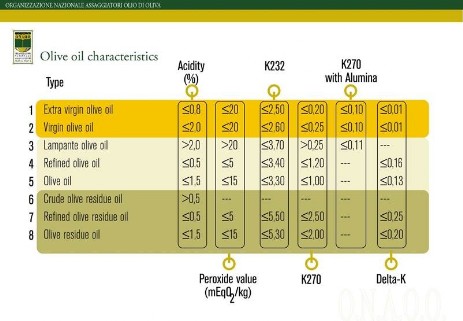Classification of olive oil in Italy
Vegetable oils are classified in chemical-physical and organoleptic characteristics.
The chemical-physical classification of olive oils is to be found in the EC Regulation n. 1513/01 dated 23-7-01, L201 (see ONAOO table). The second issue of the United States Standards for Grades of Olive Oil published by USDA in the FEDERAL REGISTER on April 28, 2010 (75 FR 22363) accepts the EC grades and adds some quality criteria in the oil purity area.
Italy is defining a new Standard of Grade which is superior quality and it includes additional criteria such as bio-phenols than Extra-Virgin Olive Oil. It will be named Alta Qualita’
The future of olive oil is in quality. This is why we have defined the Olivotto Olive Oil Quality Criteria presented in the Product section of this website
The organoleptic analysis is based on a panel of tasters that characterizes the sensorial profile based on negative and positive aspects:
The chemical-physical classification of olive oils is to be found in the EC Regulation n. 1513/01 dated 23-7-01, L201 (see ONAOO table). The second issue of the United States Standards for Grades of Olive Oil published by USDA in the FEDERAL REGISTER on April 28, 2010 (75 FR 22363) accepts the EC grades and adds some quality criteria in the oil purity area.
Italy is defining a new Standard of Grade which is superior quality and it includes additional criteria such as bio-phenols than Extra-Virgin Olive Oil. It will be named Alta Qualita’
The future of olive oil is in quality. This is why we have defined the Olivotto Olive Oil Quality Criteria presented in the Product section of this website
The organoleptic analysis is based on a panel of tasters that characterizes the sensorial profile based on negative and positive aspects:
A) The three positive attributes of olive oil are: Bitterly, Peppery and Grassy the last one is measured in terms of Median of Fruity (Mf)
B) The negative flavor and odor attributes are:
(1) Fusty. A flavor defect attributable to poor storage conditions of the olives
(2) Muddy-sediment. A flavor defect caused by storage of olive oil in contact with the sediment for long periods giving the oil a putrid flavor and odor.
(3) Musty. A flavor defect occurring when low temperatures and high humidity promote mold growth. The resulting oil has a mushroom-like odor.
(4) Rancid. A flavor defect caused by the oxidation of the oil and subsequent formation of aldehydes
(5) Winey-vinegary. A flavor defect caused by the storage condition of the olives that causes aerobic fermentation
Prof. Raffaele Sacchi ( Agricolture University of Naples ) tells that : after a full morning session on Olive oil history and tasting into a Naples primary school , the youngest boy, a six years old, said:
" Professor I think I understood : the Good Olive Oil tastes like alive olives, the bad one like dead olives ".
This is the best summary ever on organoleptics
" Professor I think I understood : the Good Olive Oil tastes like alive olives, the bad one like dead olives ".
This is the best summary ever on organoleptics
Olive oils can also be classified based on origin and production processes:
PDO. The Protected Denomination of Origin
PGI. The Protected Geographical Indication
Extra Virgin PDO Olive Oil
The PDO brand applies to productions where the entire production cycle, from raw material to finished product, is done within a delimited geographical area
PGI Extra Virgin Olive Oil
The Protected Geographical Indication (PGI) is the mark of quality that is given to agricultural products or foodstuffs where only one phase of the production process has a link with the geographical area.
Glossary
PDO. The Protected Denomination of Origin
PGI. The Protected Geographical Indication
Extra Virgin PDO Olive Oil
The PDO brand applies to productions where the entire production cycle, from raw material to finished product, is done within a delimited geographical area
PGI Extra Virgin Olive Oil
The Protected Geographical Indication (PGI) is the mark of quality that is given to agricultural products or foodstuffs where only one phase of the production process has a link with the geographical area.
Glossary

